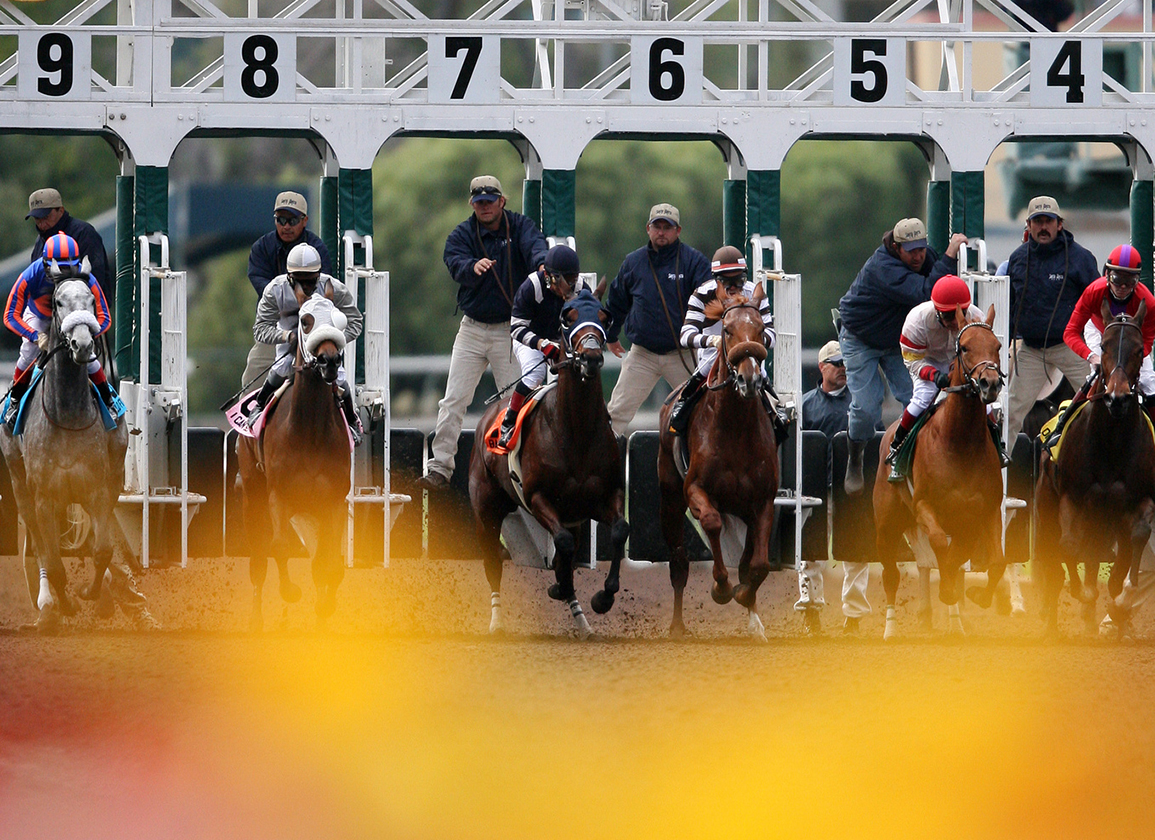By Dan Ross
The flag has already been planted midway through Santa Anita's current Winter-Spring meet, and prevailing headwinds are still driven by worries over field size.
The following table is an analysis of the average field sizes during the first 15 weeks of the Santa Anita Winter meet–a timeframe excluding Santa Anita Derby weekend–over the past five years.
In tandem with the above numbers, total handle for the meet thus far–including last weekend–decreased by 1% between last year and this, a number that comes out to nearly $8 million. That's with one extra race-day compared to last year.
On the plus side, the gross purse generation increased by 3%–for a total of $766,728–during that same period, though again with one extra race-day this year.
Arguably the biggest takeaway from the above field size table is that since 2018–that now seemingly carefree yesteryear before a welfare crisis and global pandemic wrought pandemonium–average field numbers have been on a general downward trend.
And despite average turf field sizes routinely outpacing their cousins on the dirt, even this more robust prong of the racing product is showing diminished returns when compared to just five years before.
The tale of field sizes is hardly a novel headache this year. After just six weeks into the track's current six-month sojourn, attenuated numbers prompted track management to ply a slightly different course with adjustments to what claiming races are offered, the conditions of certain maiden races, and to the length of the condition book itself.
In fairness, March's returns show improvement over the two prior months. Indeed, the overall March field size–combining dirt and turf–was marginally higher than that posted for the same month last year.
Still, when it comes to the overall health and competitiveness of Santa Anita's racing product–at least within this 15-week window–there's no escaping an imperious white-haired presence: The Bob Baffert factor on the dirt.
Over the past five years on the dirt, that trainer's percentage of overall starts, percentage of accrued purse money, and percentage of overall wins has been an upward curve.
To put the above table into perspective, during the first 15 weeks of the current season one out of every five dollars available in dirt race purse monies has funnelled into the Baffert barn.
His stable alone–one of 127 separate barns with at least one start on the dirt this season–was responsible for nearly 15% of wins on the dirt.
The concentration of firepower towards the head of the table–something the TDN has discussed before–isn't peculiar to that lone stable, however.
Here are some of the key findings from an analysis of the relative impact of the numerically larger barns during the first 15 weeks of the Santa Anita Winter meet, comparing the current season's numbers to 2018:
- In 2018, 10 trainers won 40% of all available dirt races during the first 15 weeks. This year, ten trainers have won nearly 55% of dirt races.
- Five years ago, the top ten money earning trainers made 28% of all dirt starts. This year, the top ten conditioners made 31.4% of all dirt starts—not an especially notable increase.
In terms of starts, however, this trend is more pronounced when both surfaces are examined together.
- In 2018 during the first 15 weeks, the top ten trainers in terms of prize money earned made 27.4% of all starts (dirt and turf). This year, the top 10 barns made nearly 35% of all starts.
- Five years ago, the top five trainers in terms of prize money made 16% of all starts during the first 15 weeks. This year, the top five barns made nearly 23.4% of all starts—close to a quarter of that sum.
With all this in mind, the TDN posed the following question to three key industry players, including Santa Anita general manager, Nate Newby, who responded with the following statement:
“Santa Anita is very aware of the importance of improving our field size. It's a top priority right now, second only to safety, and we plan to make a significant investment. Discussions are currently taking place both within our company and with our industry partners and stakeholders. I expect several initiatives to be finalized soon.”
Question: Given carte blanche, what three key modifications would you make to improve field sizes at Santa Anita and why?
Gary Fenton, chairman of the Thoroughbred Owners of California (TOC), and managing partner of Little Red Feather Racing
1: “What's really interesting this year is our horse population in Southern California is relatively flat versus 2021,” said Fenton, pointing out how “field size reduction and a drop in population are generally related.”
The TOC, he said, has opened a dialogue with the trainers as to why entries are down, especially as the number of workers in the morning is similarly comparable to recent years. “Hopefully these are identifiable issues we can correct,” he said.
“One key stat” concerns the operations of Peter Miller, Fenton said. The numerically powerful Miller embarked last November on a temporary hiatus from training, handing over the reins of his barn to assistant, Ruben Alvarado.
Alvarado, Fenton added, is making “far fewer starts” than his former employer. “This fact alone is, I suspect, 25% of the field size reduction.”
Note: The TDN examined Fenton's observation about the number of starters that Alvarado has made thus far at Santa Anita compared to his former employer.
In 2021, Miller made 157 starts during the first 15-weeks of the Santa Anita meet. This year, Alvarado has made 80–almost half of Miller's 2021 total.
2: “Another is our turf population and [turf] field sizes remain strong,” said Fenton, advocating for more turf racing, “even if that means expanding the turf course.”
Could an expanded grass menu arrive hand-in-hand with a new all-weather track, a natural cousin of the turf?
That depends, said Fenton. Many of his constituents at the TOC might baulk at such a proposition.
“If it's turf-Tapeta-dirt, I think I'm okay. If it means taking out the dirt, replacing it with all-weather, I think that's a larger conversation, especially in my position with a lot of different members,” he said.
3: “Lastly, we need to find a way to keep incentivizing ownership of [Cal]-breds,” said Fenton. “It's still 40% of our field size and a big reason our handle remains secure.”
What kind of incentives could that include? “You could do a lot of things,” he said, pointing to plans already in the works to expand Cal-bred opportunities in certain condition races, and his support for the Golden State Series.
“I think the Maiden Special Weight bonus is really important to Cal-breds,” said. “Without it, we'd be in some trouble. Anything we can do to help, really.”
Alan Balch, executive director of the California Thoroughbred Trainers
1: “If this was an uncomplicated situation, we wouldn't have this problem,” said Balch. “But it is a very complicated situation, this field size issue, particularly in California, which is an island unto itself.”
The first port of call, therefore, should be “urgent, strategic planning and brainstorming with all parties at the table, in the same place, at the same time,” he said.
“Everyone brings a different perspective,” Balch added. “We believe California needs to be looked at as a whole, particularly given the fact that The Stronach Group owns Santa Anita and Golden Gate. This is not the kind of serious problem that is going to be resolved in any kind of piecemeal basis.”
2: “Clearly,” said Balch, “there is an imbalance, which we believe is of historic proportion, between the so-called major trainers—that is trainers with very large stables—and the smaller trainers.”
The data needs to be analyzed to determine whether the number of “middle-sized trainers” has shrunk completely “or is a lot smaller” than it used to be, he said.
As for a fix, “we believe no subject should be off the table for strategic brainstorming,” Balch said. “This includes purse redistribution, trainer bonuses for running, incentives for smaller to mid-sized trainers and owners.”
This subject, he said, “is the type of thing where the owners and trainers' organizations need to collaborate and get to a unified position. California is the only state that the owners and trainers are in separate organizations, which is potentially part of the problem, as it inhibits free communication. We think that needs to be overcome.”
3: “The decisions must be made on basis of objective data,” said Balch. “For a sport that generates so much data, it seems so often decisions are made without reliance on the objective data.”
Not only must the data be gathered in the first place, “it must be interpreted by all of us together,” he added.
Not a subscriber? Click here to sign up for the daily PDF or alerts.








